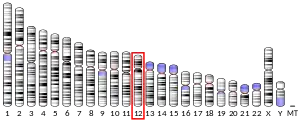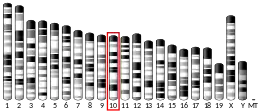Transcription factor RFX4 is a protein that in humans is encoded by the RFX4 gene.[5][6][7]
This gene is a member of the regulatory factor X gene family, which encodes transcription factors that contain a highly conserved winged helix DNA binding domain. The protein encoded by this gene is structurally related to regulatory factors X1, X2, X3, and X5. It has been shown to interact with itself as well as with regulatory factors X2 and X3, but it does not interact with regulatory factor X1. This protein may be a transcriptional repressor rather than a transcriptional activator. Three transcript variants encoding different isoforms have been described for this gene.[7]
References
- 1 2 3 GRCh38: Ensembl release 89: ENSG00000111783 - Ensembl, May 2017
- 1 2 3 GRCm38: Ensembl release 89: ENSMUSG00000020037 - Ensembl, May 2017
- ↑ "Human PubMed Reference:". National Center for Biotechnology Information, U.S. National Library of Medicine.
- ↑ "Mouse PubMed Reference:". National Center for Biotechnology Information, U.S. National Library of Medicine.
- ↑ Emery P, Durand B, Mach B, Reith W (May 1996). "RFX proteins, a novel family of DNA binding proteins conserved in the eukaryotic kingdom". Nucleic Acids Res. 24 (5): 803–7. doi:10.1093/nar/24.5.803. PMC 145730. PMID 8600444.
- ↑ Morotomi-Yano K, Yano K, Saito H, Sun Z, Iwama A, Miki Y (Jan 2002). "Human regulatory factor X 4 (RFX4) is a testis-specific dimeric DNA-binding protein that cooperates with other human RFX members". J Biol Chem. 277 (1): 836–42. doi:10.1074/jbc.M108638200. PMID 11682486.
- 1 2 "Entrez Gene: RFX4 regulatory factor X, 4 (influences HLA class II expression)".
Further reading
- Dotzlaw H, Alkhalaf M, Murphy LC (1992). "Characterization of estrogen receptor variant mRNAs from human breast cancers". Mol. Endocrinol. 6 (5): 773–85. doi:10.1210/mend.6.5.1603086. PMID 1603086. S2CID 25208340.
- Reith W, Ucla C, Barras E, et al. (1994). "RFX1, a transactivator of hepatitis B virus enhancer I, belongs to a novel family of homodimeric and heterodimeric DNA-binding proteins". Mol. Cell. Biol. 14 (2): 1230–44. doi:10.1128/mcb.14.2.1230. PMC 358479. PMID 8289803.
- Gajiwala KS, Chen H, Cornille F, et al. (2000). "Structure of the winged-helix protein hRFX1 reveals a new mode of DNA binding". Nature. 403 (6772): 916–21. Bibcode:2000Natur.403..916G. doi:10.1038/35002634. PMID 10706293. S2CID 4425783.
- Strausberg RL, Feingold EA, Grouse LH, et al. (2003). "Generation and initial analysis of more than 15,000 full-length human and mouse cDNA sequences". Proc. Natl. Acad. Sci. U.S.A. 99 (26): 16899–903. Bibcode:2002PNAS...9916899M. doi:10.1073/pnas.242603899. PMC 139241. PMID 12477932.
- Blackshear PJ, Graves JP, Stumpo DJ, et al. (2003). "Graded phenotypic response to partial and complete deficiency of a brain-specific transcript variant of the winged helix transcription factor RFX4". Development. 130 (19): 4539–52. doi:10.1242/dev.00661. PMID 12925582.
- Araki R, Takahashi H, Fukumura R, et al. (2004). "Restricted expression and photic induction of a novel mouse regulatory factor X4 transcript in the suprachiasmatic nucleus". J. Biol. Chem. 279 (11): 10237–42. doi:10.1074/jbc.M312761200. PMID 14701801.
- Glaser B, Kirov G, Bray NJ, et al. (2005). "Identification of a potential bipolar risk haplotype in the gene encoding the winged-helix transcription factor RFX4". Mol. Psychiatry. 10 (10): 920–7. doi:10.1038/sj.mp.4001689. PMID 15940297.
- Rual JF, Venkatesan K, Hao T, et al. (2005). "Towards a proteome-scale map of the human protein-protein interaction network". Nature. 437 (7062): 1173–8. Bibcode:2005Natur.437.1173R. doi:10.1038/nature04209. PMID 16189514. S2CID 4427026.
- Matsushita H, Uenaka A, Ono T, et al. (2006). "Identification of glioma-specific RFX4-E and -F isoforms and humoral immune response in patients" (PDF). Cancer Sci. 96 (11): 801–9. doi:10.1111/j.1349-7006.2005.00112.x. PMID 16271074. S2CID 25967004.
External links
- RFX4+protein,+human at the U.S. National Library of Medicine Medical Subject Headings (MeSH)
This article incorporates text from the United States National Library of Medicine, which is in the public domain.



